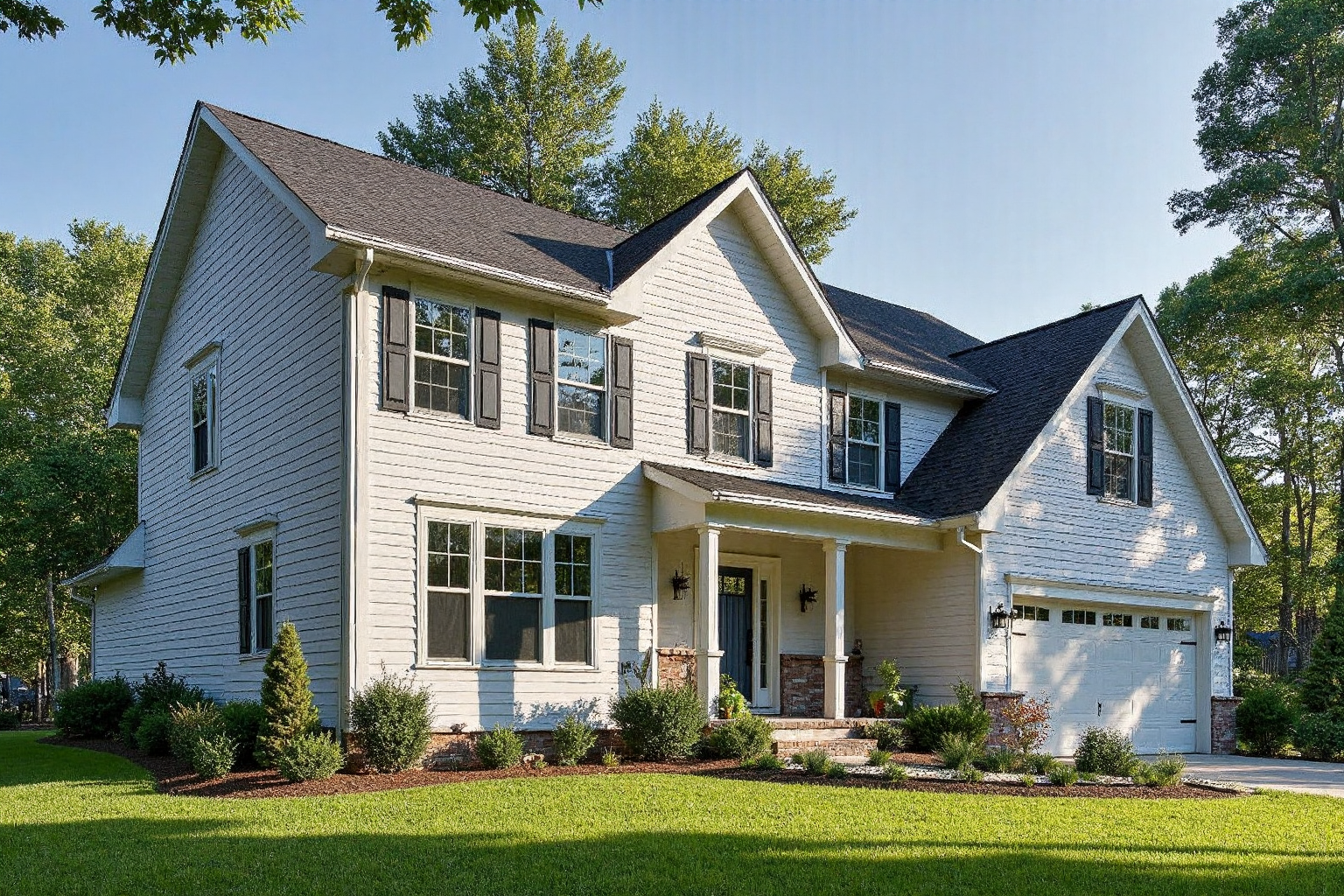Best Siding Options for Maximizing Energy Efficiency
Boost Your Home’s Energy Efficiency with the Right Siding
In an era defined by escalating energy costs and a growing awareness of environmental impact, the choice of siding for your home has transcended mere aesthetics. Upgrading to energy-efficient siding represents a strategic investment, offering a dual benefit: a substantial reduction in your home’s energy consumption and a marked improvement in its curb appeal. This comprehensive guide is designed to navigate homeowners, contractors, and DIY enthusiasts through the landscape of siding options, focusing on those that maximize energy efficiency.
We aim to equip you with the knowledge to make informed decisions, ensuring that your home is not only visually appealing but also a model of energy conservation. The right siding, therefore, is not just an exterior finish; it’s a critical component of a sustainable and cost-effective home. Selecting the best siding for insulation involves understanding several key factors. The R-value, a measure of a material’s resistance to heat flow, is paramount. A higher R-value indicates superior insulation capabilities, meaning less heat transfer through your walls.
For example, insulated vinyl siding often boasts higher R-values compared to traditional vinyl, making it a more energy-efficient choice. Airtightness is equally crucial; gaps and cracks can allow conditioned air to escape, negating the benefits of even the highest R-value siding. The material itself contributes significantly to energy performance, with options like fiber cement siding with rigid foam insulation offering excellent thermal resistance. Therefore, a holistic approach, considering both the material’s inherent properties and its installation, is essential for optimal energy efficiency.
Beyond the material itself, the installation process plays a pivotal role in maximizing the energy-saving potential of any siding. Improperly installed siding, even if it has a high R-value, can lead to significant energy losses. For instance, gaps around windows, doors, and other openings can become major sources of drafts. Therefore, meticulous sealing and insulation during installation are essential to maintain a consistent thermal barrier. This often involves using specialized tapes, sealants, and insulation materials to ensure airtightness.
In addition, proper flashing and weather barriers are critical to prevent moisture intrusion, which can degrade insulation and lead to further energy inefficiencies. Investing in professional installation is often a wise choice, as experienced contractors are well-versed in these best practices and can guarantee the long-term energy performance of your siding. When considering sustainable siding options, the environmental impact of the material also comes into play. While materials like wood siding can be renewable, their sustainability depends on responsible sourcing and treatment.
Metal siding, particularly recycled aluminum or steel, offers durability and recyclability, making it an eco-conscious choice. Fiber cement siding, while not inherently renewable, is durable and requires less maintenance, reducing its overall environmental footprint. Insulated vinyl siding, while often made from petroleum-based products, can be a highly energy-efficient option, offsetting its production impact through reduced energy consumption in the home. Therefore, a comprehensive evaluation of a material’s lifecycle, from sourcing to disposal, is essential for making an environmentally responsible choice.
The best siding for insulation is also the one that aligns with green building principles. Ultimately, the decision regarding which siding to choose should be based on a careful assessment of your specific needs, climate, and budget. While insulated vinyl siding and fiber cement siding with rigid foam insulation often provide the highest R-values and superior energy efficiency, other options like wood and metal siding can also be viable choices, particularly when coupled with proper insulation and installation techniques. The key is to prioritize energy efficiency and sustainability, recognizing that the long-term benefits of reduced energy bills and a smaller environmental footprint far outweigh the initial investment. By making informed choices, homeowners can significantly reduce energy bills with siding and create a more comfortable and sustainable home.
Key Factors and Material Options
“Understanding Energy-Efficient Siding:
A home’s exterior envelope, including the siding, plays a critical role in maintaining a comfortable indoor temperature and minimizing energy consumption. Several factors contribute to a siding’s energy efficiency, and understanding these elements is crucial for making informed decisions. The R-value, a measure of thermal resistance, is a key indicator of a material’s ability to resist heat flow. A higher R-value signifies better insulation and reduced energy loss. For example, insulated vinyl siding, with its integrated foam backing, typically boasts a higher R-value than traditional vinyl, offering enhanced thermal protection.
Airtightness is another critical factor; a well-sealed siding system prevents drafts and air leakage, further minimizing energy waste. Proper installation techniques, including meticulous sealing around windows, doors, and other openings, are paramount for maximizing the energy-saving benefits of any siding material. According to the U.S. Department of Energy, proper air sealing alone can save homeowners up to 15% on their heating and cooling bills. Beyond R-value and airtightness, thermal bridging, the transfer of heat through materials with high thermal conductivity, can impact overall energy efficiency.
Minimizing thermal bridging through proper installation techniques and material choices is essential for achieving optimal performance. Choosing sustainable siding materials with recycled content or those manufactured with environmentally friendly processes contributes to green building practices. Finally, the climate plays a significant role in determining the most effective siding choice. In colder climates, prioritizing high R-value and airtightness is crucial, while in warmer climates, reflective properties and proper ventilation become more significant.
Exploring Siding Materials:** Each siding material offers a unique blend of aesthetic appeal, durability, and energy performance characteristics.
Insulated vinyl siding provides a cost-effective way to enhance energy efficiency, combining the durability of vinyl with the added benefit of insulation. The integrated foam backing increases the R-value, reducing heat transfer and improving overall thermal comfort. Fiber cement siding, known for its resilience and low maintenance, can be further enhanced with rigid foam insulation for superior energy performance. This combination offers a robust, energy-efficient, and aesthetically versatile option for homeowners. Wood siding, while aesthetically pleasing, requires regular maintenance to preserve its appearance and protect against the elements.
Its energy efficiency can vary depending on the type of wood and the presence of additional insulation. Metal siding, particularly when paired with insulation, offers excellent energy performance. Its reflective properties can reduce heat gain in the summer, while the added insulation minimizes heat loss during colder months. Steel and aluminum are popular choices, offering durability and a wide range of color options. Traditional vinyl siding, a budget-friendly option, typically offers a lower R-value compared to insulated alternatives. While advancements in vinyl siding technology have improved its energy efficiency, it remains essential to consider the long-term energy savings offered by insulated options when making a decision. Ultimately, the best siding for maximizing energy efficiency depends on individual needs, budget, and climate considerations. Consulting with a qualified contractor can help homeowners evaluate the available options and make informed choices that align with their energy efficiency goals.” }
Installation Best Practices
“Installation Best Practices: Maximizing Energy Efficiency” Achieving optimal energy performance from your new siding goes beyond simply selecting the right material; meticulous installation is crucial. Proper installation significantly impacts the long-term energy efficiency and durability of your siding. A qualified and experienced contractor plays a vital role in ensuring that the installation maximizes the energy-saving potential of your chosen siding. They possess the expertise to address critical details that can significantly impact performance. One of the most critical aspects of energy-efficient siding installation is achieving airtightness.
This involves meticulous sealing and insulation around windows, doors, and other openings. These areas are prone to air leakage, which can negate the insulating properties of even the best siding. Experienced contractors employ advanced sealing techniques and materials, such as high-quality sealant and expanding foam, to create a continuous air barrier. This airtight envelope prevents drafts, reduces energy loss, and enhances indoor comfort. Proper insulation installation is another essential factor. While some siding options, like insulated vinyl siding, come with built-in insulation, additional insulation may be necessary to achieve optimal energy efficiency.
A qualified contractor will assess your home’s specific needs and recommend the appropriate insulation type and thickness for your climate and the chosen siding material. They will ensure proper installation to minimize thermal bridging, a phenomenon where heat transfers through less insulated areas, compromising overall energy performance. For instance, when installing fiber cement siding with rigid foam insulation, ensuring a tight fit against the sheathing minimizes thermal bridging and maximizes the insulation’s effectiveness. This integrated approach ensures that your home is well-protected against heat loss in winter and heat gain in summer.
Beyond insulation and airtightness, proper moisture management is essential for long-term siding performance and energy efficiency. Experienced contractors understand the importance of installing a weather-resistant barrier beneath the siding. This barrier protects against moisture intrusion, which can damage the siding, reduce its insulating value, and lead to mold growth. Furthermore, they ensure proper ventilation behind the siding to allow any trapped moisture to escape, preventing rot and maintaining the integrity of the wall assembly. This attention to detail ensures that your siding investment contributes to a healthy and energy-efficient home environment for years to come.
Selecting the right contractor is paramount for maximizing the energy-saving benefits of your siding investment. Look for certified contractors with a proven track record of successful energy-efficient siding installations. Ask for references and examples of their work, and inquire about their familiarity with the specific type of siding you’ve chosen. A knowledgeable contractor will provide a detailed assessment of your home’s energy needs and recommend the best installation practices to achieve optimal performance. They should also be able to advise on maximizing energy savings by combining energy-efficient siding with other strategies, such as proper attic insulation and ventilation, and upgrading to energy-efficient windows and doors.
By taking a holistic approach, you can significantly reduce your energy bills, enhance your home’s comfort, and contribute to a more sustainable future. Finally, always ensure your chosen contractor pulls the necessary permits and adheres to local building codes. This protects your investment and ensures the work meets quality and safety standards. By combining careful material selection with meticulous installation by a qualified professional, you can transform your home’s exterior into an energy-efficient and aesthetically pleasing asset.
Cost-Effectiveness and Return on Investment
While insulated vinyl siding and fiber cement siding with rigid foam insulation stand out as premier choices for energy efficiency, their higher initial costs often give homeowners pause. However, it’s crucial to view these expenses not as mere expenditures, but as long-term investments that yield substantial returns through reduced energy consumption. The superior R-value of these materials directly translates to lower heating and cooling bills, and over time, these savings can more than compensate for the upfront price difference.
For example, a homeowner in a climate with harsh winters might see a dramatic reduction in their heating costs after installing insulated vinyl siding, potentially recouping the additional expense within a few years, making it a financially sound choice over the lifespan of the home. To accurately assess the cost-effectiveness of different siding options, it’s essential to conduct a thorough lifecycle cost analysis. This analysis should consider not only the initial purchase and installation costs, but also the long-term expenses associated with maintenance, repairs, and energy consumption.
For instance, while wood siding might have a lower initial cost, it requires regular maintenance, such as painting or staining, which can add to the overall expense. In contrast, fiber cement siding, while more expensive upfront, is known for its durability and low maintenance requirements, offering a more cost-effective solution over the long run. Moreover, the energy savings from a high-R-value siding contribute to this long-term financial benefit. Beyond the direct financial benefits, selecting energy-efficient siding contributes to the broader goals of green building and sustainability.
By reducing energy consumption, homeowners can lessen their carbon footprint and contribute to a more environmentally responsible future. Sustainable siding options, such as those made from recycled materials or sourced from responsibly managed forests, further enhance the environmental appeal. For example, some metal siding options are made from recycled aluminum, offering a durable and eco-friendly alternative to other materials. Choosing a siding with a high R-value not only cuts down on your energy bills but also reduces the demand for energy from the grid, contributing to a more sustainable energy system.
Furthermore, the impact of energy-efficient siding extends beyond individual homes to the community level. When a significant number of homes in a neighborhood adopt best siding for insulation practices, the overall energy demand decreases, leading to a more resilient and sustainable local energy infrastructure. This collective shift towards energy-efficient building practices can result in lower utility rates and a reduced strain on the power grid. Consider a community where many homes have installed insulated vinyl siding; the combined effect of these improvements would significantly reduce the overall energy consumption of the neighborhood, demonstrating the power of collective action in achieving energy efficiency.
Therefore, when evaluating siding options, homeowners should look beyond the initial price tag and carefully consider the long-term financial and environmental implications. A thorough cost-benefit analysis, encompassing energy savings, maintenance costs, and the environmental impact, will help guide them toward making the most informed and financially sound decision. Investing in energy-efficient siding is not just about reducing energy bills; it’s also about increasing the value of your home, contributing to a more sustainable future, and creating a more comfortable and efficient living space. This holistic approach ensures that the chosen siding option is not only cost-effective but also aligns with the principles of green building and responsible homeownership.
Maximizing Energy Savings and Next Steps
Maximizing energy savings through energy-efficient siding is most effective when integrated with a comprehensive approach to home energy management. While the right siding material, such as insulated vinyl siding or fiber cement with rigid foam, can significantly improve a home’s thermal envelope, it’s crucial to address other areas of potential energy loss. For example, ensuring proper attic insulation and ventilation is paramount, as a poorly insulated attic can negate the benefits of even the best siding for insulation.
According to the U.S. Department of Energy, inadequate attic insulation can account for up to 25% of a home’s energy loss. Combining enhanced siding with proper attic sealing and insulation creates a more robust and effective barrier against temperature fluctuations. This holistic strategy ensures that your investment in energy-efficient siding yields the maximum possible reduction in energy bills. Addressing air leaks is another critical step in optimizing your home’s energy performance. Even with high-R-value siding, drafts around windows, doors, and other openings can substantially undermine its insulating capabilities.
Careful sealing of these areas with caulk or weather stripping, particularly around window and door frames, is essential. This not only prevents conditioned air from escaping but also keeps outside air from entering, further reducing the workload on your heating and cooling systems. The EPA estimates that air leaks can increase energy bills by as much as 20%, making air sealing a crucial complement to any siding upgrade. Therefore, when planning your siding project, consider a thorough home energy audit to pinpoint and correct any existing air leaks.
This synergistic approach will maximize the return on your investment in energy-efficient siding. Furthermore, selecting energy-efficient windows and doors can amplify the overall impact of your siding upgrade. Older, single-pane windows are often a major source of heat loss and gain. Replacing these with energy-efficient windows, such as those with low-E coatings and multiple panes, can drastically reduce energy consumption. Similarly, upgrading old or poorly fitted doors with insulated options will further enhance your home’s thermal performance.
These improvements, combined with high-performance siding, will create a tighter, more energy-efficient building envelope. For instance, choosing double-pane windows with a low-E coating and argon gas fill can reduce energy loss through windows by as much as 30% compared to single-pane windows. The combination of energy-efficient siding, windows, and doors will substantially reduce your reliance on heating and cooling systems, leading to significant long-term cost savings. For homeowners considering sustainable siding options, the lifecycle impact of materials should also be considered.
While insulated vinyl siding offers excellent thermal performance and low maintenance, other materials like fiber cement siding and even wood siding from sustainably managed forests can also be considered. Fiber cement siding, while requiring more initial investment, boasts durability and longevity that contribute to its sustainability. Wood siding, when sourced responsibly and properly treated, can be a carbon-neutral option. Metal siding, particularly when recycled, also provides a sustainable and durable alternative with high reflectivity that can reduce cooling loads in warmer climates.
Therefore, when evaluating the best siding for insulation, considering the environmental impact of the material in addition to its R-value and other performance characteristics is crucial for a truly green building approach. Ready to upgrade your home with energy-efficient siding? Consulting with reputable and experienced siding contractors is crucial for obtaining accurate quotes and exploring the options best suited to your home’s specific needs and architectural style. Experienced professionals can assess your home’s unique challenges and provide tailored solutions, ensuring that your siding installation maximizes energy efficiency and aesthetic appeal.
For DIY enthusiasts, thorough research and careful planning are essential for a successful project. This includes understanding local building codes, proper installation techniques, and the specifics of the chosen siding material. Remember, the long-term benefits of energy-efficient siding, such as reduced energy bills and a more comfortable home, make the initial investment a worthwhile endeavor. By taking a holistic and informed approach, you can create a more energy-efficient and sustainable home for years to come.


